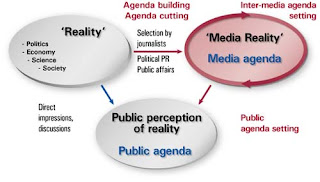"And I believe that good journalism, good television, can make our world a better place"
-Christiane Amanpour-
This course has re-establish in my mind of the power of journalism and, from this, the influential role the media possesses in the current world climate. I have always appreciated the degree of importance in the functioning of media outlets, and my love for broadcast television personalities has always been reflected in the programs I choose to watch. However, JOUR1111 taught me to look further than what is just presented to us (print, broadcast, radio etc.), and to see the methods by which the media uses in the portrayal of issues.
In looking back over the topics studied this semester, such as Old and New Media sources, text news sources, photo journalism, a sound lecture speaking of radio, Commercial and Public Media, ethics in the media, news values, agenda setting, investigative journalism and a lecture by a professional Blogger, it was evident of the degree to which we were introduced to varying media sources.
I feel I learnt a lot about the world of journalism in the study of the Media Agenda Setting. As already outlined in this blog, Media Agenda Setting is all about the way the mass media presents certain issues frequently and predominately. Ultimately, the more coverage an issues receives by the media, the more important it is deemed by the public. I really felt the presence of this concept in the portrayal of any news issues.
One of my favourite television news programs is A Current Affair, when watching this program I began to notice the presence of agenda setting. Their program has the ability to determine what is important in the public eye by the way and frequency of coverage on an issue.
Below is a clip from The Chasers War On Everything about the portrayal of people in the media. I feel this is a form of Agenda Setting in that the media reflects how the public should interpret the people by the way the issue is presented. The Chasers program has an excellent ability to point the agenda settings of the media.
Another element of this course I found highly interesting was the lecture centred around ethics. I enjoyed the structure of this lecture in that we were very involved in the deciding of whether the advertisements were in good or bad taste. In viewing a variety of comical advertisements and unethical or ethical television campaigns, I felt I really learnt of the transformation of what is deemed appropriate in the current media world. It amazed me how people reacted to different campaigns and advertisements which is addressed previously in this blog.
The final part of this course that I found educational was the study of Investigative Journalism. I am a very interested in the world of investigative journalism so I found this lecture incorporated a lot of what I plan to do after University. Therefore, this lecture was good for me.
I felt that a lot of the informational content of this course was obvious in that it is clear what a journalist is employed to do. The lectures that I found the most obvious were News Values (it was clear what would take priority in a news broadcast or article), as well as the lecture based on photo journalism. Even though the content was obvious in some cases, I felt it needed to be covered for myself, as a student, to grasp the entire concept of journalism.
Throughout this course we were asked to keep a blog that we updated after every lecture and tutorial that gave us time to reflect on the concepts learnt. At first I wasn't too keen on constant blogging, however I began to treat it like a personal diary, in that it became quite personal in its depth. We were told to include something in our blog that we loved, and this is why I wrote about shoes. I love journalism and I love shoes, so it didn't take long before I loved writing on my blog. The concept of blogging was an excellent idea for this course and it really allowed me to learn more about the topics of JOUR1111.
In conclusion, prior to commencing this course I was adamant that I wanted to do broadcast journalism, however, in just 12 short weeks, I have learnt of the diversity in journalism. I was always aware of there being print, online, broadcast or radio journalism, although the degree in change between each was always lost on me. The way you conduct yourself, the way you change the way you write, and the issues in which are covered are all so dramatically different between the many different media sources.
This course allowed me to fall deeper in love with journalism and helped me decide on my future occupation.
10.06.2012

















